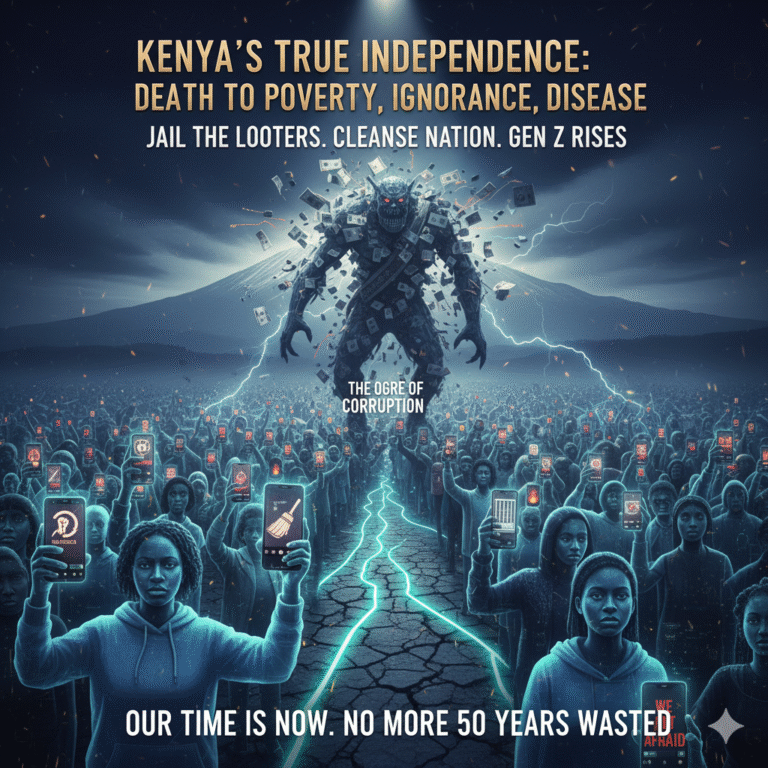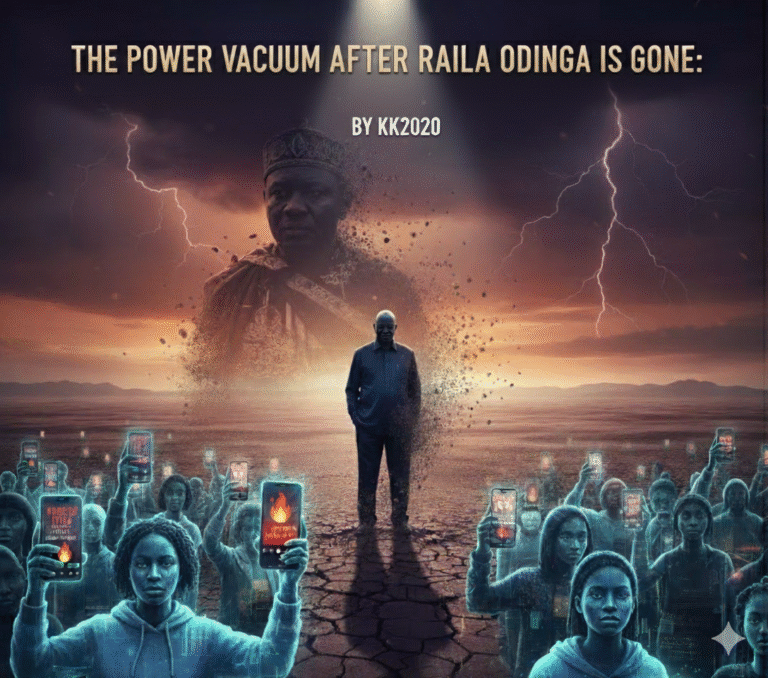
Now That His Stabilizer Raila Odinga Is Gone, What Will Happen to Besieged Ruto? What Next for the Gen Z Revolution?
William Ruto is standing alone now. The political shield that once softened the public rage—Raila Odinga—is out of his orbit. The handshake, the ceasefire, the illusion of unity between government and opposition—all of it has faded. Kenya is drifting into a raw season. The power balance that once held through calculated silence and symbolic gestures is breaking down.
Raila’s silence had functioned like anesthesia. His meetings with Ruto, his measured tone, his absence from active opposition calmed tempers that were near explosion. Gen Z’s street heat cooled, not because they lost interest, but because the voice they expected to roar against power began to whisper. His departure to international politics removes that last barrier between a restless population and a regime that has exhausted excuses.
Ruto’s administration now faces its first true test without an adult in the room. For months, Raila had become the stabilizer—his cooperation lending Ruto temporary legitimacy. The truce helped the president breathe. But that air was borrowed. Without it, the cracks in his rule look deeper. Discontent is not confined to opposition strongholds anymore; it runs through Mount Kenya, Rift Valley, the Coast, and Nairobi’s estates.
The government’s hold on the youth has collapsed. The administration tried to brand the protests as chaos funded by foreign powers or political enemies. But the youth were not following a party. They were following anger. Unemployment, rising taxes, police killings—these built the rebellion. It was organic, leaderless, and allergic to manipulation. Raila’s exit means there is no veteran politician left to contain that energy.
Ruto’s political survival depends on how he handles the Gen Z question. The youth no longer respect the old playbook—tribal arithmetic, church endorsements, or empty slogans. They see through every PR stunt. Online, every government statement is dissected, mocked, rejected. The generation that once stayed silent during injustices now records everything, posts it, and turns it into a national conversation within hours. The regime cannot outpace their communication power.
The digital space has become a parliament of its own. TikTok lives, X spaces, YouTube commentaries—these have replaced the political rallies that once defined Kenyan activism. In that world, the president’s words carry no sacred weight. Memes ruin state propaganda faster than official denials can land. And unlike traditional politics, Gen Z doesn’t wait for 2027. They act now. Their movement has no clear leader, which makes it impossible to negotiate with or arrest into silence.
Ruto’s style of governance was built for a country that still feared authority. But this Kenya has changed. The youth do not see the president as untouchable. They challenge him openly, ridicule his speeches, and question his wealth. The charm that carried him from “hustler” to head of state has lost its pull. Every new tax proposal, every foreign trip, every lavish government expenditure fuels resentment. The anger no longer simmers—it circulates.
Without Raila’s political brakes, the next uprising could be harder to contain. The state’s old tactics—police intimidation, internet shutdowns, disinformation—have already been tested and failed. Shooting protesters no longer silences them; it multiplies the outrage. Each name added to the casualty list becomes a rallying cry. The funerals turn into mass mobilizations. The chants are no longer about policy—they’re about justice.
If the youth light the revolution again, it won’t be the same movement. The first wave was spontaneous, emotional, experimental. The next will be organized, informed, and less forgiving. The demands will sharpen from “Stop the Finance Bill” to structural change: term limits enforced, independent judiciary protected, public funds traced in real time, and state contracts opened for scrutiny.
Kenya’s young population is not just protesting; it’s studying. They’ve seen how other nations unseat regimes, how information can dismantle authority faster than bullets. The state’s weakness lies in visibility—everything is recorded. Every convoy, every inflated project cost, every statement contradicting data—it all becomes content. The government’s image is losing its monopoly.
Ruto’s team seems to believe that time will wear out the protests. But this generation doesn’t fade out easily. The recession, joblessness, student loans, delayed salaries—these ensure that anger never runs dry. It’s no longer about a single policy or scandal. It’s about the lived experience of a government detached from reality. Raila’s absence has left that anger unfiltered.
Politically, Ruto faces an internal crisis too. His Mount Kenya alliance is shaking. Rigathi Gachagua’s silence has grown colder, his allies more distant. Rift Valley MPs are quietly grumbling about unfulfilled promises. The political coalition that brought Ruto to power feels transactional now. Without Raila as a counterweight, the infighting could grow unchecked. Ruto’s survival may depend on manufacturing new enemies to unite his base—yet every manufactured crisis exposes desperation.
The next phase of the Gen Z revolution will likely reject both Ruto and Raila’s political systems. The youth no longer want saviors; they want systems that work. They have no patience for the “hustler vs. dynasty” narrative. That story collapsed when Ruto’s government began behaving exactly like the dynasties it condemned. Private jets, luxurious offices, inflated budgets—symbols of the same elite arrogance Kenyans voted to end.
If the movement resurfaces, it might start from universities, jobless graduates, and civil servants whose paychecks shrink every month. From there, it could spread across counties, tied together not by political leaders but by digital platforms. That kind of decentralized activism is unpredictable. The state can’t infiltrate it because it has no command structure. One viral post can mobilize thousands before intelligence services even notice.
The police will likely respond with force again, but each confrontation erodes public trust further. The state can’t arrest half the population. The courts, already under pressure, may start siding with citizens to preserve legitimacy. Once the judiciary begins pushing back, Ruto’s executive power will weaken. Parliament, too, will sense the shift and start distancing itself to protect future electoral chances. Political loyalty will turn fluid.
If Ruto wants to survive, he needs to pivot fast. Cosmetic reshuffles won’t work anymore. The country is too informed, too connected. Promises must translate into visible change. Ending wasteful spending, cutting foreign travel, firing corrupt officials, empowering counties—these are not political favors anymore; they’re survival tactics.
But reforming means fighting his own allies, many of whom financed his campaign. That’s the trap. His power is built on patronage networks that expect payback through tenders, appointments, and kickbacks. Turning against them would isolate him; keeping them means alienating the public. Every option bleeds.
The Gen Z movement is not waiting for politicians to lead them. They’re building their own media, their own investigative collectives, their own digital watchdogs. They crowdsource evidence, expose scandals, and archive everything. They’ve turned political accountability into open-source work. That scares the state more than marches. This is a generation that records the police before running. They know their rights, they quote constitutional articles on live streams, and they don’t fear authority figures.
Old politics can’t handle that. When young protesters speak directly to the president through live broadcasts, bypassing state media, they redefine the idea of citizenship. Leadership is no longer sacred; it’s service. And when leadership fails, it’s ridiculed publicly, instantly. That humiliation drives regimes into defensive overreach—censorship, intimidation, surveillance—all of which backfire.
Ruto’s communication team seems stuck in campaign mode, not governance. The “bottom-up” slogan now sounds hollow to every struggling household. Food prices, housing costs, school fees—these remain untouched. The hustler dream feels like a cruel joke. The regime’s inability to admit mistakes worsens the resentment. Every denial deepens the credibility gap.
If the Gen Zs reignite the revolution, it will not just be about removing Ruto—it will target the political class as a whole. MPs, senators, governors—all of them could face public rejection. The protests could evolve into a new kind of civic movement, one that demands citizen assemblies, independent budgeting oversight, and digital transparency tools.
Kenya has reached a saturation point. Every scandal looks like a repeat of the last one. The hunger for accountability has turned generational. Parents may still fear the police, but their children record them. That’s the transition point. The youth’s defiance is cultural now, not just political. They are rewriting what resistance means.
Ruto’s survival depends less on Raila’s replacement and more on his ability to read this cultural shift. Old alliances won’t hold. The youth won’t rally behind tribal kings anymore. They want competence, fairness, and visible results. If Ruto continues playing traditional politics—rewarding loyalty over skill, defending cronies over citizens—his administration will decay faster than any before it.
The regime’s biggest weakness is perception. Every day of inaction, every scandal ignored, every tone-deaf statement feeds the image of a president disconnected from reality. Raila’s exit magnifies that void. There’s no older figure left to absorb the anger. It all lands on Ruto now.
If Gen Zs decide to light the revolution again, the government will be facing a movement smarter, broader, and less forgiving. The next protest won’t be just about tax. It will question why Kenya’s richest keep getting richer while the rest sink. It will question the police chain of command that justifies shooting citizens. It will demand the resignation of leaders who can’t explain their wealth. It will name names and present evidence.
The coming years could mark either reform or rebellion. The administration can choose transparency and regain some trust, or it can continue using fear and lose it all. Once legitimacy erodes, even loyal security forces hesitate to act. That’s when regimes begin to collapse internally—quiet refusals, missed orders, soft mutinies.
Ruto’s government looks strong on paper but hollow in spirit. Too many citizens have stopped believing anything it says. Without Raila to negotiate calm or mediate tempers, that disbelief will turn volatile. The street has learned its strength. The youth have discovered they can bring a government to its knees without formal leadership. That realization cannot be undone.
Kenya is entering uncharted ground. The next chapter won’t be written in parliament or at rallies—it will be written online, on pavements, in the voices of citizens who’ve lost patience. Ruto still has time to shift, but not much. The stabilizer is gone. The nation is watching. And this time, nobody stands between him and the people he governs.
Click Here to Enjoy KWM Podcast



